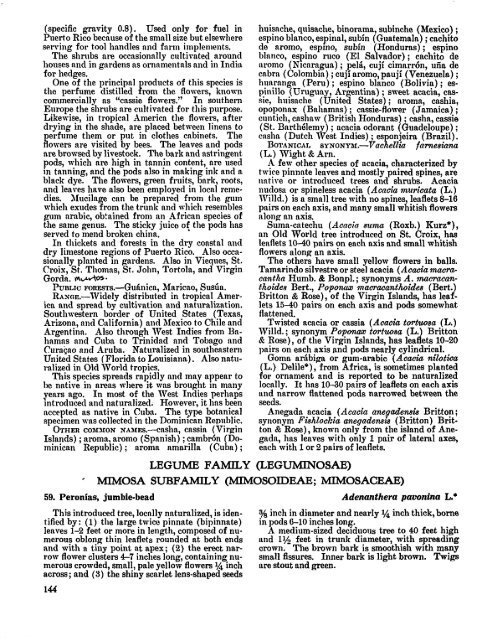Common Trees of Puerto Rico and the Virgin Islands
Common Trees of Puerto Rico and the Virgin Islands
Common Trees of Puerto Rico and the Virgin Islands
Create successful ePaper yourself
Turn your PDF publications into a flip-book with our unique Google optimized e-Paper software.
(specific grnvity 0.8). Used only for fuel in<br />
<strong>Puerto</strong> <strong>Rico</strong> because <strong>of</strong> <strong>the</strong> small size but elsewllere<br />
serving for tool h<strong>and</strong>les <strong>and</strong> farm implements.<br />
The shrubs are occasionally ciiltivated around<br />
houses <strong>and</strong> in gardens as ornamentals <strong>and</strong> in Indin<br />
for hedges.<br />
One <strong>of</strong> <strong>the</strong> principal roducts <strong>of</strong> this species is<br />
P<br />
<strong>the</strong> perfume distilled rom tho flowers, known<br />
commercially as "cassie flo\vers." In sou<strong>the</strong>rn<br />
Europe <strong>the</strong> shrubs are cultivated for this purpose.<br />
Likewise, in tropical America <strong>the</strong> flowers, after<br />
drying in <strong>the</strong> shade, are placed between linens to<br />
erfume <strong>the</strong>m or put in clo<strong>the</strong>s cabinets. The<br />
[owen are visited by bees. The leaves <strong>and</strong> pods<br />
are browsed by livestock. The bark <strong>and</strong> astringent<br />
pods, which are high in tannin content, are used<br />
in tnnning, <strong>and</strong> <strong>the</strong> pods also in makin ink <strong>and</strong> a<br />
black dye. The flowers, green fruits, 6 ark, roots,<br />
<strong>and</strong> leaves have also been employed in local remedies.<br />
Mucilage can be prepared from <strong>the</strong> gum<br />
which exudes from <strong>the</strong> trunk <strong>and</strong> I\-hich resembles<br />
pim arabic, obtained from an African species <strong>of</strong><br />
<strong>the</strong> same genus. The sticky juice <strong>of</strong> <strong>the</strong> pods has<br />
served to mend broken china.<br />
In thickets <strong>and</strong> forests in <strong>the</strong> dry coastal ancl<br />
dry limestone regions <strong>of</strong> <strong>Puerto</strong> <strong>Rico</strong>. Also occasionally<br />
planted in gardens. Also in Vieques, St.<br />
Croix, St. Thomas, St. John, Tortola, <strong>and</strong> <strong>Virgin</strong><br />
Gorda. m a -<br />
PUBLIC I.~REsTs.-Gu~~~c~, Maricao, Susfia.<br />
R~x~~.-\vide]y distributed in tropical America<br />
<strong>and</strong> spread by cultivation <strong>and</strong> naturalization.<br />
South\vestern border <strong>of</strong> United States (Texas,<br />
Arizona, <strong>and</strong> California) <strong>and</strong> Mexico to Chile ancl<br />
brgentina. -41~0 through West Indies from Bnhamas<br />
<strong>and</strong> Cubn to Trinidad <strong>and</strong> Tobago <strong>and</strong><br />
Curai;no <strong>and</strong> Aruba. Naturalized in sou<strong>the</strong>astern<br />
United States (Florida to Louisiana). Also naturalized<br />
in Old World tropics.<br />
This species spreads rapidly <strong>and</strong> may appear to<br />
be native in areas where it was brought in many<br />
years ago. In most <strong>of</strong> <strong>the</strong> West Indies perhaps<br />
introducecl <strong>and</strong> naturalized. However, it has been<br />
accepted as native in Cuba. The type botanical<br />
speclmen was collected in <strong>the</strong> Dominican Republic.<br />
OTHER COBIJION NAB~FS.--C~S~~~, cassia (<strong>Virgin</strong><br />
Isl<strong>and</strong>s) ; aroma, aromo (Spanish) ; cambrbn Doininican<br />
Republic) ; aroma amarilla (Cu a) ;<br />
b<br />
LEGUME FAMILY (LEGUMINOSAE)<br />
' MIMOSA SUBFAMILY (MIM :OSOIDEAE; MIMOSACEAE)<br />
59. Peronias, jumbie-bead<br />
This introduced tree, locally naturalized, is iden-<br />
tified by: (1) <strong>the</strong> large twice pinnate (bipinnate)<br />
leaves 1-2 feet or more in length, composed <strong>of</strong> nu-<br />
merous oblong thin leaflets rounded at both ends<br />
<strong>and</strong> with a tiny point at apex; (2) <strong>the</strong> erect nar-<br />
row flower clusters 4-7 inches long, containing nu-<br />
merous crowded, small, pale yellow flowers 1/4 inch<br />
across ; <strong>and</strong> (3) <strong>the</strong> shiny scarlet lens-shaped seeds<br />
huisache, qtiisache, binorama, subinche (Mexico) ;<br />
espino blanco, espinal, subin (Guatemala) ; cachito<br />
de aromo, espmo, subin (Hondurns) ; espino<br />
blanco, espino ruco (El Salvador) ; cachito de<br />
nromo (Nicarngua) ; pelti, cuji cimarrbn, uiia de<br />
cnbra (Colombia) ; cuji aromo, pauji (Venezuela) ;<br />
111inrangn (Peru) ; espino blanco (Bolivia) ; espinillo<br />
(Uruguay, Argentina) ; sweet acacia, cassie,<br />
huisache (United States) ; aroma, cashia,<br />
opoponax (Bahamas) ; cassie-flower (Jamaica) ;<br />
cuntich, cashaw (British Honduras) ; casha, cassie<br />
(St. Barthglemy) ; acacia odorant (Guadeloupe) ;<br />
cttsha (Dutch JVest Indies) ; es onjeira (Brazil).<br />
BOTQANICAL SYNONYM.-Vac ellk famesiana<br />
(L.) Wight & Arn.<br />
A few o<strong>the</strong>r species <strong>of</strong> acacia, characterized by<br />
twice pinnate leaves <strong>and</strong> mostly paired spines, are<br />
untire or introduced trees <strong>and</strong> shrubs. Acacia<br />
nudosa or spineless acacia (Acacia muricata (L.)<br />
Willd.) is a small tree with no spines, lenflets 8-16<br />
pairs on each axis, <strong>and</strong> many small whitish flowers<br />
along an axis.<br />
Suma-cntechu (Accrcicr sum (Roxb.) Kurz*) ,<br />
an Old World tree introduced on St. Croix,. has<br />
leaflets 10-40 pairs on each axis <strong>and</strong> small whitish<br />
flowers along an axis.<br />
The o<strong>the</strong>rs have small yellow flowers in balls.<br />
Tamnrindo silvestre or steel acacia (Acacia mcra-<br />
cantha Humb. & Bonpl. ; synonyms A. macracan-<br />
thoides Bert., Poponux macracanthoides (Bert.<br />
Britton B: Rose), <strong>of</strong> <strong>the</strong> <strong>Virgin</strong> Isl<strong>and</strong>s, hss leaf-<br />
lets 1540 pairs on each axis <strong>and</strong> pods somewhat<br />
flattened.<br />
Twisted acacia or cassia (Acacziz tortzlosa (L.)<br />
Willd. ; synonym Poponax torfuosa (L.) Britton<br />
b Rose), <strong>of</strong> <strong>the</strong> <strong>Virgin</strong> Isl<strong>and</strong>s, has leaflets 10-20<br />
pairs on each axis pnd pods nearly cylindrical.<br />
Goma arjbiga or gum-arabic (Acacie nizotica<br />
(L.) Delile*), from Africa, is sometimes planted<br />
for ornament <strong>and</strong> is reported to be naturalized<br />
locnlly. It has 1030 pairs <strong>of</strong> leaflets on each axis<br />
<strong>and</strong> narrow flattened pods narrowed between <strong>the</strong><br />
seeds.<br />
Anegadn acacia (Acacia anegadeneis Britton;<br />
synonym Fish1ocl:ia anegademia (Britton) Brit-<br />
ton & Rose), known only from <strong>the</strong> isl<strong>and</strong> <strong>of</strong> Ane-<br />
gada, has leaves with only 1 pair <strong>of</strong> lateral axes,<br />
each with 1 or 2 pairs <strong>of</strong> leaflets.<br />
P<br />
Adenan<strong>the</strong>ra pavonina L.*<br />
3h inch in diameter <strong>and</strong> nearly 4/4 inch thick, borne<br />
in pods 6-10 inches long.<br />
A medium-sized deciduous tree to 40 feet high<br />
<strong>and</strong> 1v2 feet in trunk diameter, with spreading<br />
crown. The brown bark is smoothish wlth many<br />
small fissures. Inner bark is light brown. Twigs<br />
are stout <strong>and</strong> green.

















